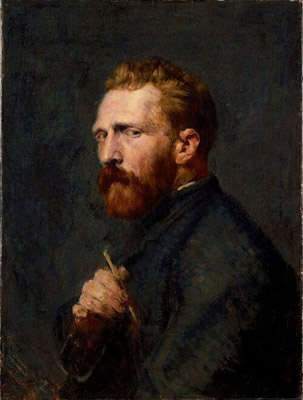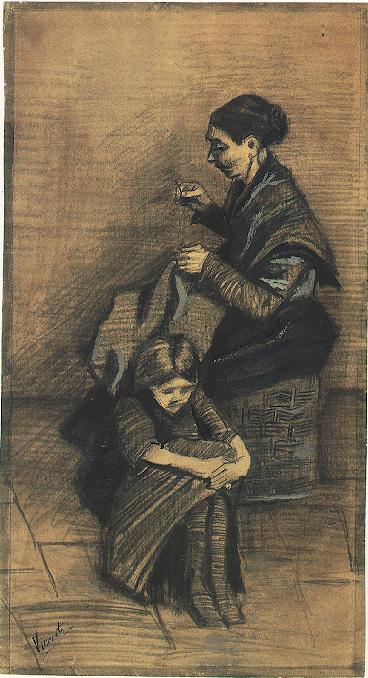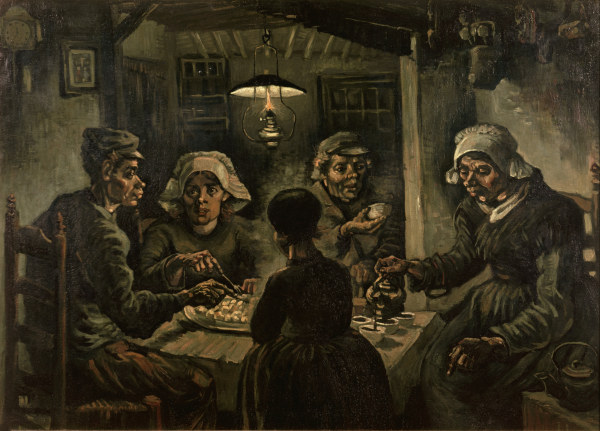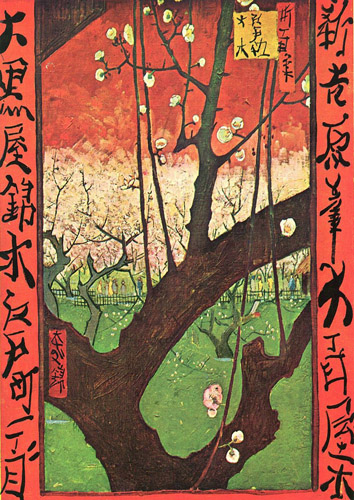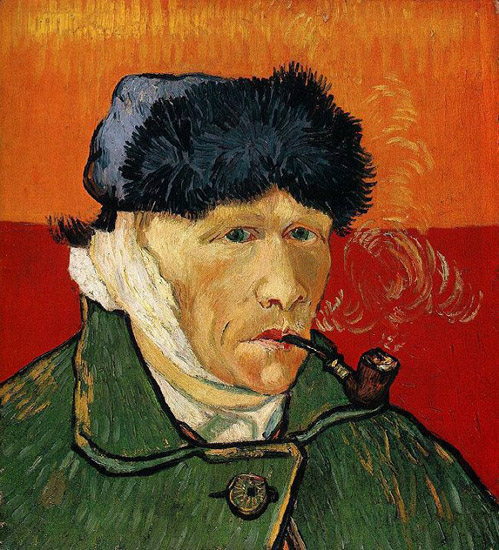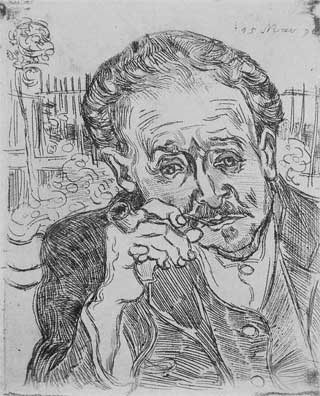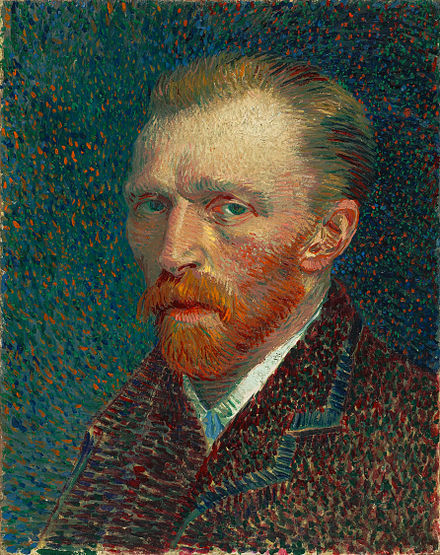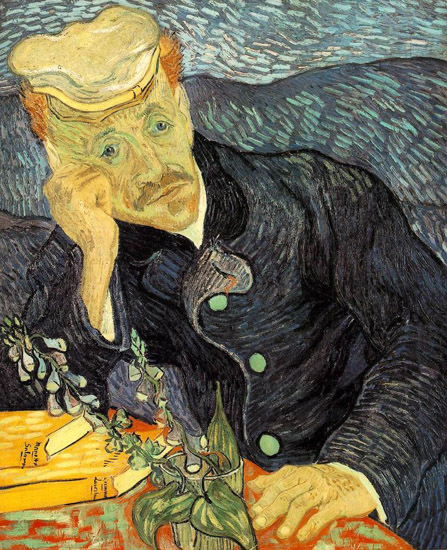A Brief Biography of the Life of Vincent van Gogh and itís Influences on His Art by Alvin James
Vincent Willem van Gogh was born the son of pastor on March 30, 1853 in Holland (Leeuw). From his very birth, a dark shadow was cast that would symbolize the emotional torment that he would suffer throughout his life. On March 30, 1852 van Goghís mother had given birth to a stillborn son whom they had also named Vincent. This incident may have been considered of little consequence had it not been for the tragic life that was to follow. From 1861 to 1869 van Gogh received a basic education from several different schools (Leeuw). His education came to an abrupt end around the age of 16, but of the cause of this, little is known. In 1869, unaware of his own artistic abilities, Vincent van Gogh became employed, with the help of an uncle, as an apprentice to an art dealer by the international art dealers, Goupil & Cie (Butterfield 5). Three years later in 1872 Vincent begins a regular correspondence with his younger brother Theo that would continue with only a few brief interruptions for the rest of his life. The following year Theo van Gogh is hired by Goupil & Cie but remained at the Brussels branch, while Vincentís spent the majority of his time at the branches The Hague and London (Leeuw). It was while working here that Vincent first became fascinated with the styles of painters and developed a sense for what he believed was good art. He allowed his ideas about quality artwork to interfere with his job as an art dealer. It has been reported that if a customer became interested in a painting that Vincent van Gogh believed was of poor quality he would go to great lengths to talk them out of their purchase (Butterfield 5). Vincentís employers grew unhappy with his unsavory business practices and he was dismissed from Goupil & Cie in March of 1876. While working in London, Vincent was also exposed to, for the first time, the feeling of heartbreak. Vincentís first failed attempt at love occurred when he fell in love with Eugenia Loyer, the daughter of his London landlord (Leeuw). Although he had never approached her with his feelings, Vincent created a fantasy romance in his mind. He believed that her love for him matched or even exceeded his own. When he did find the courage to confess his love to her, he was crushed to find that she was already engaged to another. Vincent refused to accept this fact and continued his pursuits of Eugenia. It was only during a summer vacation to the Netherlands that he began to let go of his want for her. Although this was Vincentís first crushing introduction to love, it would not be his last. After his failure as an art dealer, with the help of a relative Vincent became employed as a teacher. After a short stint as a teacher Vincent returned home to Holland to visit his parents. He decided to stay in Holland with his parents and took a position as a bookseller at a local bookshop. Vincent realized that he was inadequate as a bookseller, and his parents were beginning to see him as a failure. In a last ditch attempt to satisfy the desires of his parents, Vincent van Gogh decided that he would follow in his fathers footsteps and entered into the ministry. With the aid of another one of his relatives, van Gogh was able to secure a position as a missionary preacher in a mining district in Belgium (Butterfield 6). While he worked in the mining camp, van Gogh was known for selflessness and his tendency to give away his clothes and money to aid the poor. Although his generosity was great, van Gogh was not able to effectively communicate the word of God to his parishioners and he soon realized that life as a minister suited him no more than that of an art dealer. After leaving his ministry, van Gogh entered into a deep depression and stopped correspondence to Theo from October 1879 to July 1880 (Walther 41). When Vincent finally renewed contact with his brother, he was a changed man; he was an artist. In 1880, Vincent van Gogh moved to Brussels to begin his formal art training. While a student Vincent put a great deal of effort into mastering his craft (Walther 60). For a while, it seemed as if the life of Vincent van Gogh were turning around. His artistic calling was approved by his entire family, and in April of 1881 Vincent returned to his parents home (Walther 61). But Vincent found that those around him had a much different conception of art than he did and this caused him a great deal of sorrow. It was during this time of depression that Vincent fell in love with his recently widowed cousin Kee. But just as before, the object of his affections had no interest in him. Despite Kee's lack of interest in Vincent, he continued to pursue her, all the while professing his love. Eventually Kee's father intervened and would not allow Vincent to see his daughter. In a desperate display Vincent placed his hand in the flame of a kerosene lamp and said, "Let me see her (Kee) for as long as I can keep my hand in the flame" (Butterfield 6). Vincent's intimate advances brought shame on his family's name and caused a life long break in his relationship with his father. Vincent's love for his cousin had a huge impact on his art. It was during this time that he developed some of the fundamental concepts that historians still associate with his art today. The idea of emancipation became very important to Vincent and it became a central theme in his artwork. The importance of freedom to Vincent can be easily seen in a letter that he wrote to Theo, in which he said: "May your profession be a modern one and may you help your wife to obtain a modern soul, free her of the awful prejudices that shackle her" (Walther 63).
In the summer of 1882 Vincent, along with Sien and her children, moved to a larger apartment (Walther 77). This proved to be a very productive time for his artistic pursuits. In August of 1882 alone, Vincent produced a series of several dozen oil paintings. In Sien, Vincent had found a sort of kindred spirit. He was deeply empathetic to the emotional and physical torments that she experienced and poured that empathy into his artwork. These were good times for Vincent, but they would shortly come to an end. He began to realize that he could no longer afford to support both Sien and her children and his artwork on the money that was provided to him by Theo. As a result of their tight financial position, Sien returned to a life of prostitution. Vincent could not accept this decision and in September of 1883 he broke off his love affair and moved to a much poorer part of town where working conditions were extremely bad and his art suffered (Walther 78). Vincent was forced to choose between his art and his family and he chose to leave them. The guilt of this decision would torment him for the rest of his life. For the three months after he left Sien, Vincent van Gogh lived alone and in extreme poverty. His own poverty prompted him to incorporate the life of the underprivileged into his art. In many ways it was under these destitute conditions that Vincent finally found some inner peace. During this period he wrote to his brother saying, "There are some things we feel to be good and trueÖeven if much remains inexplicable and obscure from a rational, calculating point of view. And although in the society we live in actions of this kind are considered foolish or crazy or I donít know what- there is not much to be said about it when hidden forces of attraction and love have awoken within usÖHe who has preserved his belief in a God will occasionally hear the quiet voice of conscience, and at such times it is good to obey it with the naivety of a child" (Walther 91). In the autumn of 1883, Vincent limited his painting almost exclusively to peasant cottages. And although his sense of inner peace persisted, he began to be tormented by his decision to leave Sien and her children to fend for themselves. He wrote to Theo expressing the guilt over his decision saying, "Theo whenever I am out on the heath and I come across a poor woman with a child in her arms or at her breast, the tears come to my eyes. It is her that I see; their weakness and sluttishness seem only to heighten the resemblance" (Walther 100). By December of 1883, Vincent could not endure his living conditions any more and returned to his parents home. While living with his parents, Vincentís output again began to soar. He produced a great number of everyday scenes from the countryside that surrounded him. It was also during this time that Vincent van Gogh was commissioned for the first and last time to paint a picture. Initially there was some tension between Vincent and his parents, but this faded after Vincentís mother broke her leg. His motherís injuries required her to be bedridden for several months and during this time he dedicated himself to caring for her.
In Paris, Vincent was introduced to a new group of artistic colleagues and discovered the meaning of Impressionism. While in Paris, van Goghís use of color blossomed as he immersed himself in the Impressionist style. He left painting the dark canvas that was typical of his earlier work unless in a state of depression. Vincentís paintings after Paris are distinctly more colorful and bold than his previous work [e.g., compare "Potato Eaters" (1885) to "Self-Portrait with Grey Felt Hat"(1886)]. But the changes in Vincentís life that took place in Paris were not limited to his art. While in Paris he developed a love for the nightlife. He drank frequently and was a regular visitor of the local prostitutes.
Near the summer, Vincent's condition seemed to be improving and then unexpectedly on July 27 he shot himself in the chest. He was taken to a local hospital and survived there for two days before dying from his wounds. Vincent's brother, Theo, arrived before his brother passed and was able to share his last moments. Theo recorded his last words to be: "I wish it were all over now" (Walther 718). Theo died the following year and was buried next to his brother in the cemetery at Auvers (Walther 719). Vincent van Goghís Style and Portrait Art Vincent van Gogh set the stage for the development of a new artistic style called Expressionism (Butterfield 1). This is a style of painting that expresses the artist's inner feelings and emotions about his subject. Vincent van Gogh tried to describe his intentions in painting to his sister by saying, "I do not know if you can understand that it is possible to express poetry by means of a good arrangement of colors and nothing more, just as one can express consolation by means of music. In addition the bizarre, contrived and repetitive lines that twist through the whole picture are not meant to represent the garden as it normally looks, but to render it as we might see it in a dream, in its true character, yet at the same time stranger than reality" (Walther 452). This style was not accepted by many of Vincent's friends and contemporaries who believed that the Impressionist style was the key to creating great works of art. Despite their criticism, Vincent van Gogh ushered in a new era of Expressionist art and influenced generations of future artists. The "Potato Eaters" is likely the greatest masterpiece that Vincent van Gogh produced in his early years (before Paris). Vincent explained in a letter to his brother that he was interested in emphasizing that the peasants were eating with the same dirty hands that had dug up the potatoes. He wanted this piece to speak of manual labor and how these people had honestly earned their food (Leeuw). While working on this painting he was encouraged by friends to improve the physical correctness of the subjects in his painting to make them appear more realistic. He responded to this criticism by saying, "My great longing is to make those very incorrectnesses, those deviations, remodelings, changes in reality, so that they may become, yes, lies if you like- but truer than the literal truth" (Leeuw). "Potato Eaters" (1885) Some of Vincent's greatest accomplishments as an artist came in the form of the self-portraits that he painted. No other artist, with the exception of Rembrandt who experienced a much longer painting career, rivals the number of self-portraits that he painted. In less than five years time (1885-1889) Vincent produced over thirty self-portraits. These paintings vary greatly due to Vincent's ever-changing use of Impressionistic and Neo-Impressionistic brushwork. Over the years he applied colors in varying thickness and direction from portrait to portrait, but in all there is extraordinary detail given to the expression in the eyes. The first of the self-portraits that he painted were traditional, stylistic, and painted with a dark palette like his earlier portraits of peasants (e.g. Potato eaters). These early portraits lacked the use of any of the brighter colors that he would later use frequently. After being exposed to Impressionism after visiting Paris, Vincent began to include more brilliant colors in his self-portraits. In his final self-portraits, Vincent painted himself with the same colors he used for his backgrounds; this technique gave the paintings the illusion that he was fading into his surroundings. It is possible that this was a technique used to foreshadow his imminent death. Vincent writes to his sister about his series of self-portraits: "My intention is to show that a variety of very different portraits can be made of the same person" (Leeuw). Here he most likely meant that as a persons moods and feelings change, so should their portrait as seen through the eyes of the Expressionist artist.
|
